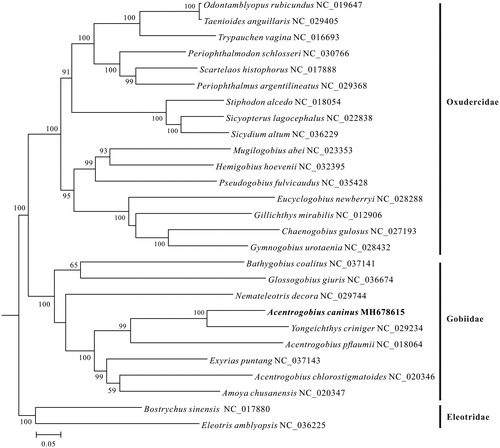Abstract
At present, only several species of genus Acentrogobius were described and information of mitochondrial DNA were also just focused on two species. Here, the complete mitochondrial genome of Acentrogobius caninus was completely sequenced by high throughput sequencing method. The complete mitochondrial genome was 16,614 bp in length, consisted of 13 protein-coding genes, 22 tRNA genes, 2 rRNA genes, 1 large non-coding control region, and 1 light-strand replication origin. Overall base composition values for the mitochondrial genome were 28.24, 29.20, 16.77, and 25.79% for A, C, G, and T, respectively. The gene arrangement is identical to those in typical fishes. Phylogenetic tree based on 13 protein-coding genes shows that three species of genus Acentrogobiu did not cluster into one clade.
The species tropical sand goby, Acentrogobius caninus (Gobiiformes, Gobiidae), is widely distributed throughout the Indo-west Pacific, and it lives in muddy and sandy bottoms of mangrove estuary in South China Sea and Taiwan Strait (Mao et al. Citation2009; Zhong Citation1997). Studies on A. caninus were seldom, only the length–weight and length–length relationship were researched (Nahar, et al., Citation2017). Many species of Acentrogobius have not been well recognized, and only species A. pflaumii (Jin et al. Citation2012) and A. chlorostigmatoides (Yang et al. Citation2016) have sequenced the complete mitogenomes. So here we described the complete mitochondrial genome of A. caninus and reconstructed the phylogenetic relationship of the relative species of Gobiidae and expecting for better understanding the systematic evolution of the genus Acentrogobius and further phylogenetic study of Gobiiformes.
The specimen was collected from Naozhou island in Zhanjiang, China (geographic coordinate: N 20°53′20.11″, E 112°28′46.20″). The specimen was preserved in ethanol and registered to the Marine Biodiversity Collection of South China Sea, Chinese Academy of Sciences, under the voucher number SW20181071708.
The complete mitochondrial genome of A. caninus was 16,614 bp in length (GenBank accession No. MH678615), containing 13 protein-coding genes, 22 tRNA genes, 2 rRNA genes, a control region (CR) as well as one light-strand replication origin (OL). The gene arrangement is identical to those in typical fishes that most of these genes are encoded by the H-stand, except for ND6 and eight tRNA genes (tRNA-Gln, -Ala, -Asn, -Cys, -Tyr, -Ser, -Glu, and -Pro) (Boore Citation1999; Jin et al. Citation2012; Yang et al. Citation2016). Overall base composition values for the mitochondrial genome were 28.24, 29.20, 16.77, and 25.79% for A, C, G, and T, respectively, showing slightly AT-bias of 54.03%.
The 13 protein-coding genes encode 3803 amino acids in total. Except COI using GTG, the remaining 12 protein-coding genes start with ATG. Most of them use TAA or TAG as the stop codon, while COIII and Cytb use an incomplete T, COII and ND4 use an unusual AGA. As in other vertebrates, the two non-coding regions, the larger one CR (977 bp) located between tRNA-Pro and tRNA-Phe, and an OL located within the WANCY region.
A maximum likelihood (ML) phylogeny tree was constructed by using MEGA6 (Tamura et al. Citation2013), based on the sequences of 13 protein-coding genes of each mitogenome from 25 species from Gobiidae and Oxudercidae, with Eleotris amblyopsis and Bostrychus sinensis from Eleotridae as outgroup species. The ML tree showed that three species of genus Acentrogobius did not cluster into one clade (). A. caninus and Yongeichthys criniger clustered together, and then joined with A. pflaumii, while A. chlorostigmatoides, Amoya chusanensis, and Exyrias puntang formed another branch.
Figure 1. Maximum-likelihood phylogenetic tree was constructed based on the sequences of 13 protein coding genes of 27 species. The number at each node is the bootstrap probability (≥50%). The number after the species name is the GenBank accession number, and the bold species is studied in this research.

Disclosure statement
The authors declare that there is no conflict of interest regarding the publication of this article. The authors alone are responsible for the content and writing of the paper.
Additional information
Funding
References
- Boore JL. 1999. Animal mitochondrial genomes. Nucleic Acids Res. 27:1767–1780.
- Jin X, Wang R, Zhao S, Xu T, Shi G. 2012. Complete mitochondrial genome of the striped sandgoby Acentrogobius pflaumii (Perciformes, Gobiidae). Mitochondrial DNA. 23:420–422.
- Mao W, Huang ZY, Shi FS, Wang WQ. 2009. Are vegetated areas of mangroves attractive to juvenile and small fish? The case of Dongzhaigang Bay, Hainan Island, China. Estuar Coast Shelf Sci. 85:208–216.
- Nahar A, Hanif MA, Siddik MAB, Chaklader MR, Islam MA. 2017. Length–weight and length–length relationships of four endemic fish species caught from Payra River, Southern Bangladesh. J Appl Ichthyol. 34:1–3.
- Tamura K, Stecher G, Peterson D, Filipski A, Kumar S. 2013. MEGA6: molecular evolutionary genetics analysis version 6.0. Mol Biol Evol. 30:2725–2729.
- Yang QH, Lin Q, He LB, Huang RF, Lin KB, Ge H, Wu JS, Zhou C. 2016. The complete mitochondrial genome sequence of Acentrogobius sp. (Gobiiformes: Gobiidae) and phylogenetic studies of Gobiidae. Mitochondrial DNA A DNA Mapp Seq Anal. 27;2927–2928.
- Zhong JS. 1997. Review the classification of Acentrogobius Bleeker, 1874 (Perciformes; Gobiidae) from China. J Shanghai Fish Univ. 6:200–211.
